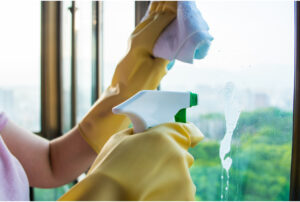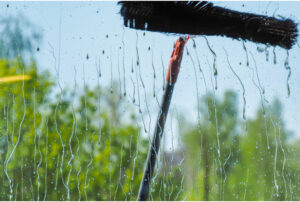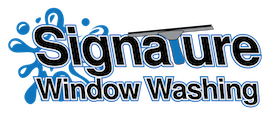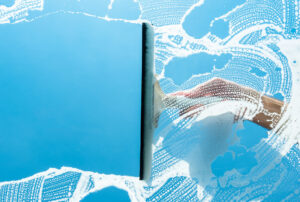Have you ever wanted to clean your windows and make them look like new? Window cleaning can be a tedious task, and often it seems like no matter how hard you scrub, there are still streaks or residue left behind. But what if we told you that there is a way to get perfectly clean windows without all the effort? With a few simple steps, you can make deionized water for window cleaning that will leave your windows sparkling. Window Cleaning Services
Understanding Deionized Water
Deionized water is an important part of window cleaning. It’s a special type of water that has had its mineral ions removed, so it doesn’t leave any streaks or residue behind when used for window cleaning. It’s also not as harsh on the surfaces you’re cleaning, making it great for window cleaners who are looking to get the job done without damaging the glass.
Deionized water is produced through a process called ion-exchange or reverse osmosis. This process works by passing water through a series of resins that attract and remove positively charged ions like calcium and magnesium, leaving only neutral molecules in the final product. This makes deionized water ideal for window cleaners who need a streak-free finish but don’t want to use harsh chemical cleaners on their windows.
Using deionized water in window cleaning can help keep your windows looking clean and spotless without risking damage from chemical cleaners. It’s also more cost effective than many other types of window cleaner, making it an attractive option for those who want to save money while still getting great results with minimal effort!
Benefits Of Using Deionized Water
Using deionized water for window cleaning has several benefits. It is free of minerals and salts, meaning it’s free from contaminants that can lead to streaky windows. Additionally, hydrogen peroxide can be added to the deionized water to make an effective window cleaning solution. This gives it antibacterial properties, making it a great choice for use in hospitals or other public places.
Deionized water also dries faster than regular tap water, as there are no minerals present that can cause spots or streaks. It also allows for a greater degree of control with regards to the concentration of the window cleaning solution used on the windows. And when combined with a microfibre cloth, deionized water can leave windows sparkling clean without requiring any elbow grease at all.
In summary, using deionized water for window cleaning has numerous advantages over traditional solutions such as tap water and commercial window cleaners. Its lack of contaminants means windows stay streak-free after each clean while its combination with hydrogen peroxide makes it a powerful sanitizer and cleaner – perfect for public spaces like hospitals or schools.
Preparation Of Deionized Water
When it comes to window cleaning, deionized water offers several advantages that make it an ideal choice for customers. To ensure the best results, it’s important to prepare the deionized water correctly. Here’s a look at how to do it.
The first step is filling a spray bottle with deionized water. Make sure you use a new spray bottle and thoroughly clean any residue from previous uses. Once this is done, you can add the deionized water and secure the lid of the bottle tightly.
The next step is adding your favorite window cleaning solution to the spray bottle. This can be done by measuring out the recommended amount and pouring it into the spray bottle containing the deionized water. Be sure to tighten the lid securely once again before shaking up the contents of the bottle until they are completely mixed together.
Using this mixture in your window cleaning routine will provide superior results compared to using ordinary tap water or other solutions. By following these steps, you’ll have everything you need for a successful clean every time!
Supplies Needed To Make Deionized Water
If you want to make deionized water for window cleaning, there are a few supplies you’ll need. First, you’ll need some baking soda or a water softener. This will help remove any impurities from the water. You’ll also need essential oils like lemon or lavender, which will add an extra layer of protection against any lingering odors in the water. Lastly, you’ll need some paper towels to wipe down the windows before applying the deionized water.
Once all your supplies are collected, it’s time to start making the deionized water. To start, pour a cup of baking soda into a gallon of filtered or distilled water and mix them together until completely dissolved. Then add your desired essential oil and stir it around until it’s evenly distributed in the solution. Finally, strain out any remaining particles using paper towels or cheesecloth and let sit overnight.
Your deionized water is now ready for use! Simply dip your towel into the solution and wipe down your windows as needed – no rinsing required! Enjoy crystal clear window panes without streaks of dirt or residue left behind!
Steps To Make Deionized Water
Making deionized water is an important part of making a window cleaning solution. This type of water doesn’t contain any minerals or impurities, making it ideal for creating a high-quality solution. To make deionized water, you’ll need some basic supplies that are easy to find.
First, gather two buckets, a filter system, and some distilled water. You’ll also need a measuring cup and dish soap. Once you have all the necessary equipment, it’s time to start the process of making deionized water.
Start by filling one bucket with distilled water and adding the filter to it. Then use the measuring cup to measure out two tablespoons of dish soap and add them to the bucket with the filter. After mixing well, pour this mixture into the second bucket until it’s full. The filtered mixture will now be your deionized water which can be used for carpet cleaning or as a window cleaning solution.
Once you’re finished, you’ll have perfectly clean deionized water that’s ready to use in whatever cleaning project you have in mind! It’s an easy process that yields high-quality results every time.
Ph Level Of Deionized Water
When it comes to cleaning services, deionized water can make a big difference. It has a much lower pH level than regular tap water, meaning it won’t leave residue behind that can cause streaks or spots on glass surfaces. While mixing up your own deionized water is not difficult, it’s important to understand the pH level you’re aiming for.
Producing deionized water requires adding an acid such as lemon juice or vinegar to the tap water. The pH of the resulting solution will depend on how much acid was used – a higher amount of acid will result in a lower pH level. The ideal pH for window cleaning should be around 6-7, so if your solution is too acidic you’ll need to add more tap water and test again until you reach the desired level.
For professional cleaners, using ready-made glass cleaner solutions with deionized water is often the preferred option since it allows them to get consistent results without having to go through the process of testing and adjusting their own mixture. This ensures they are able to provide quality service without worrying about leaving behind streaks or spots on their clients’ windows.
Storing Deionized Water
When it comes to window cleaning, deionized water is the go-to choice for many professional cleaning services and house cleaners. It’s important to understand how to properly store this type of water so that you can use it for a long time without having to replace it. Here are some tips for storing deionized water in order to get the most out of it.
First, make sure that when you purchase or create your own deionized water that it is stored in a clean container without any residue from previous cleaning products or other materials. This will help it remain uncontaminated and last longer. Additionally, always keep the container sealed when not in use and store it in a cool, dry place away from direct sunlight. To ensure maximum shelf-life of your deionized water, use a container with an opaque color rather than clear or translucent containers.
Another important factor when storing deionized water is temperature control. Make sure you don’t store it at temperatures above 80 degrees Fahrenheit since any higher could cause damage to the natural pH balance of the liquid and render it unusable for window cleaning purposes. If you have concerns about maintaining an ideal temperature range, consider using an insulated cooler with ice packs or frozen bottles of water alongside the container of deionized water.
By following these tips and using high-quality deionized water, you’ll be able to achieve streak-free windows while also making sure that you’re getting the most out of your investment in this specialized form of window cleaning solution.
How To Properly Use Deionized Water For Window Cleaning
Using deionized water for window cleaning is an effective and efficient way to keep windows sparklingly clean. To make sure you’re using it properly, there are a few tips you should know. First, it’s important to mix the deionized water with rubbing alcohol or cream of tartar for better results. This will help break down grease and grime that has built up on the glass. Additionally, when using the mixture to clean shower doors, make sure to use a squeegee or microfiber cloth afterward in order to avoid any residue streaks left behind.
Finally, be sure not to use too much of the mixture as this can cause problems with the window seals or frames. Instead, use just enough of the solution to lightly dampen a soft cloth before wiping down the window surfaces. The key is to ensure that no excess moisture is left behind after you’re done cleaning which could damage the windows if not taken care of correctly.
By using deionized water mixed with rubbing alcohol or cream of tartar and applying it correctly, you can get your windows looking like new again in no time!
Advantages Of Window Cleaning With Deionized Water
Using deionized water for window cleaning has many advantages. It is non-toxic, so it won’t harm the environment if it’s disposed of improperly. Additionally, it doesn’t leave any residue or streaks on the windows, making them look crystal clear when you’re finished. Its lack of impurities also means that cleaning services can use it without worrying about staining or tarnishing their clients’ windows.
Deionized water also offers superior cleaning power compared to regular tap water. Because it has fewer contaminants and minerals in it, it can cut through dirt and grime more effectively. This means that a single cleaning session with deionized water can be more effective than multiple sessions with regular tap water.
Finally, deionized water is cheaper than most other window cleaning solutions, making it the ideal choice for budget-conscious businesses and homeowners alike. It’s also easy to obtain; many local stores carry containers of deionized water specifically designed for window cleaning needs. With its cost-effectiveness and superior results, using deionized water for window cleaning is definitely worth considering.
Disadvantages Of Window Cleaning With Deionized Water
Deionized water is often preferred for window cleaning, but there are some potential drawbacks to consider. Firstly, deionized water requires more effort and expense to produce than regular tap water. Deionized water must be filtered through a specialized type of filter that can remove ions, resulting in an H2O molecule with no charge. This process adds to the cost of the water, which can be prohibitive for many people.
Another issue with window cleaning with deionized water is that it can leave streaks on the glass surface. The lack of ions present in deionized water prevents it from bonding well with surfaces and leaves a residue behind after drying. For this reason, it is important to use a squeegee or other tool to help wipe away any remaining droplets.
Finally, deionized water has a higher pH level than regular tap water. This means that it can cause corrosion on metal surfaces over time if not properly rinsed off and dried after use. For this reason, it’s important to take extra precautions when using deionized water for window cleaning and make sure you thoroughly rinse and dry any metal features after use.
Tips For Using Deionized Water Effectively
Using deionized water for window cleaning has its advantages; however, it is important to know how to use it effectively. The key to making sure that you get the most out of your deionized water is understanding the process and knowing which steps to take. This article will provide some tips for using deionized water effectively.
Firstly, it is important to make sure that you are using clean containers when creating your deionized water. Containers should be filled with distilled or reverse osmosis filtered water before adding any chemicals. Additionally, when mixing the solution, the liquid should be stirred slowly and not shaken or agitated too much as this can cause foaming.
Finally, once you have created your deionized water solution, it should be stored in a cool dry place away from direct sunlight. This ensures that any chemical reactions do not occur and that the solution remains effective for longer. It is also important to ensure that there is no contamination of the solution during storage by keeping it away from other chemicals or solvents and regularly checking the pH level of the solution with a test strip.
By following these tips and taking extra care when preparing and storing your deionized water, you can ensure that you get maximum results out of your window cleaning session.
Safety Precautions For Window Cleaning With Deionized Water
When it comes to window cleaning, safety is always a top priority. When using deionized water, it’s important to take extra precautions to ensure that the job is done safely and effectively. In this article, we’ll discuss the safety precautions that should be taken when using deionized water for window cleaning.
Firstly, make sure that you are wearing the appropriate protective gear when cleaning windows with deionized water. This includes gloves, eye protection, and a face mask. This will help protect your skin from any potential hazards from the solution and prevent any splashes of deionized water from getting into your eyes or mouth. Additionally, you should also wear long sleeves and trousers to cover as much skin as possible while cleaning.
Secondly, use a lint-free cloth when wiping down the windows with deionized water. This will help to avoid leaving behind streaks or dust particles on the surface after wiping down with the solution. You should also use a squeegee or scrubbing brush if necessary in order to remove any dirt or debris before applying the deionized water. Lastly, make sure that you dispose of any used rags or paper towels properly afterwards in order to keep your workspace safe and clean.
By following these tips for using deionized water for window cleaning safely and effectively, you can ensure that your windows stay sparkling clean without putting yourself at risk of harm.
Common Problems With Window Cleaning With Deionized Water
When using deionized water for window cleaning, it’s important to be aware of common problems that might arise. One issue is spotting, which is when spots or streaks form on the windows after cleaning. This can happen if the deionized water isn’t completely clean and still contains minerals, or if there’s too much soap residue left on the surface. Another possible problem is fogging, which occurs when tiny droplets of moisture form on the window after drying. This happens when the deionized water evaporates too quickly and doesn’t leave enough time for the window to dry properly.
It’s also important to pay attention to how you’re applying the deionized water and cleaning solution. Too much pressure when wiping can cause scratches on the glass, while not using enough pressure can lead to smudges or streaks. Additionally, using a dirty cloth or sponge can transfer dirt onto the windows rather than removing it.
These problems can be avoided by making sure you use a high-quality source of deionized water with no minerals present, as well as an appropriate amount of soap residue in your cleaning solution. You should also use a clean cloth or sponge with just enough pressure when wiping down the windows, and give them plenty of time to dry before moving on to another task.
Troubleshooting Tips For Window Cleaning With Deionized Water
Using deionized water for window cleaning is a great way to get windows squeaky clean without leaving behind streaks or residues. However, it’s not uncommon to encounter problems when using this method. To help you troubleshoot and ensure your windows are spotless, here are some tips.
First off, make sure you’re using the right ratio of DI water and cleaning solution. While it may vary depending on the product you’re using, typically a 3:1 ratio of DI water to cleaner is ideal. Too much cleaner can leave behind residue, while too little can result in streaks.
Another tip is to use lint-free cloths and squeegees when cleaning with DI water – avoid paper towels or regular cloths that might leave lint behind. When drying windows with a squeegee, remember to start at the top and drag downwards in one continuous motion until you reach the bottom of the window. This will prevent any streaks from forming.
Finally, if there are still streaks after cleaning with DI water, add a few drops of rubbing alcohol or vinegar to your solution – this will help remove any stubborn residue without leaving behind additional spots or streaks. With these tips in mind, you can be sure that your windows will be sparkling clean!
Frequently Asked Questions About Window Cleaning With Deionized Water
When it comes to window cleaning, deionized water is often the material of choice. This is because it does not contain any minerals or other elements that can leave smudges and residue on surfaces. But there are some common questions about how to use deionized water for window cleaning that need answering. In this article, we’ll be exploring some frequently asked questions about window cleaning with deionized water.
The first question people have is: how do you make deionized water? Generally speaking, it’s a fairly simple process. You start by boiling regular tap water in order to remove any dissolved solids, then passing the boiled water through a filter media such as activated carbon or resins. This removes any remaining ions and produces pure, deionized water suitable for window cleaning.
Another common query is what kind of equipment is needed for using deionized water in window cleaning? Generally speaking you don’t need much extra equipment – just a source of hot water and a filter system as described above are all that’s required. However, some specialist tools like pressure washers may be needed depending on the size of the windows and the type of dirt being removed.
In summary, deionized water makes an excellent choice when it comes to window cleaning due to its ability to leave surfaces free from streaks and residue. The method for producing it involves boiling tap water and passing it through a filter media such as activated carbon or resins, then additional equipment may be necessary depending on the size and type of dirt needing removal. With these answers in mind, anyone can get started with using deionized water for their window cleaning needs in no time at all!
In conclusion, understanding how to make deionized water for window cleaning can help save you money and time. Deionized water is a great choice for window cleaning because it won’t leave streaks or spots on your windows. Preparing deionized water involves gathering the supplies needed and following the proper steps. When cleaning with deionized water, it is important to follow safety precautions and be aware of any potential problems that may arise. Lastly, if you have any trouble or questions when using deionized water for window cleaning, there are many troubleshooting tips and frequently asked questions available to help you out. With the right knowledge and resources, you can easily make deionized water for window cleaning.


Recent Comments